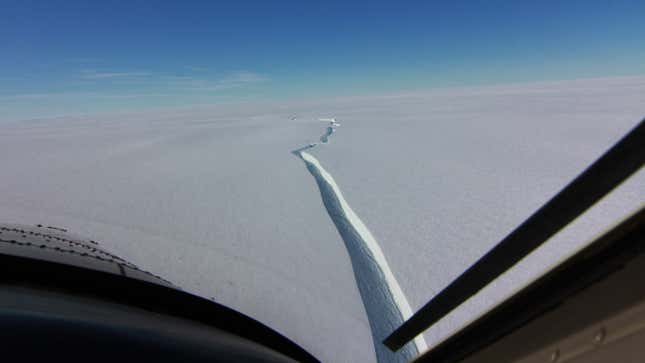
An iceberg more than 20 times the size of Manhattan split off from the Brunt Ice Shelf in Antarctica this week because our planet is totally having a normal one.
The ginormous iceberg measures roughly 490 square miles (1,270 square km) and is nearly 500 feet (150 meters) thick, according to the British Antarctic Survey. BAS scientists captured an aerial view of it, which you can check out below in a video that’s eerily reminiscent of that one scene at the beginning of The Day After Tomorrow.
BAS scientists have seen three major cracks develop in the floating ice shelf over the past decade. Warning signs of an imminent calving event started last November when a new chasm, called the North Rift, emerged and started heading toward another major crack roughly 21 miles (35 km) to the northeast. In January, the rift crept further in that direction, moving at about half a mile (1 km) per day, before widening substantially in the span of hours on Feb. 26, causing the iceberg to cut itself loose. According to the European Space Agency, the Brunt Ice Shelf hasn’t seen a major calving event like this since 1971.
In a press release, BAS director Jane Francis explained the organization had long anticipated this day.
“Our teams at BAS have been prepared for the calving of an iceberg from Brunt Ice Shelf for years. We monitor the ice shelf daily using an automated network of high-precision GPS instruments that surround the station, these measure how the ice shelf is deforming and moving,” she said.
Per the release, this calving event shouldn’t pose any immediate threat to the BAS’ base on the ice shelf, known as the Halley Research Station, but scientists are monitoring the situation.
“This is a dynamic situation,” said BAS director of operations Simon Garrod. “Four years ago we moved Halley Research Station inland to ensure that it would not be carried away when an iceberg eventually formed. That was a wise decision.”
“Our job now is to keep a close eye on the situation and assess any potential impact of the present calving on the remaining ice shelf. We continuously review our contingency plans to ensure the safety of our staff, protect our research station, and maintain the delivery of the science we undertake at Halley,” he continued.
While undoubtedly huge, this iceberg is still dwarfed by the massive chunk that broke off from Antarctica’s Larsen C Ice Shelf in 2017, which recently threatened to collide with South Georgia Island and is among the largest ever recorded at 2,240 square miles (5,800 square km).
And though you’d (understandably) be quick to point the finger at climate change for such dramatic calving events, scientists have made it clear that these could also be natural occurrences. Just a horrifying step in the lifecycle of an ice shelf: It grows until it’s too big to support itself, collapses, and then the whole process starts again. There’s no evidence linking this latest iceberg to the Larsen C Ice Shelf calving event or the effects of climate change, BAS said.
The question now is what will happen next. The iceberg will need to be monitored in case it strays too close to commercial shipping lanes or fragments even further. And while climate change may not have directly caused the chunk to break off, the increasing temperature of waters and changing flow patterns could certainly influence where it goes from here. In all likelihood, it’ll splinter into increasingly smaller pieces, living on vicariously through its baby icebergs until those, too, eventually melt away.